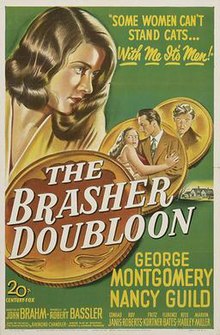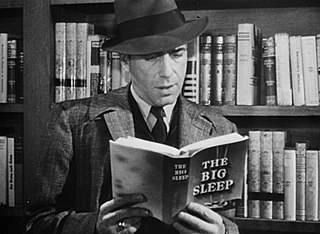
Philip Marlowe is a fictional character created by Raymond Chandler who was characteristic of the hardboiled crime fiction genre. The genre originated in the 1920s, notably in Black Mask magazine, in which Dashiell Hammett's The Continental Op and Sam Spade first appeared. Marlowe first appeared under that name in The Big Sleep, published in 1939. Chandler's early short stories, published in pulp magazines such as Black Mask and Dime Detective, featured similar characters with names like "Carmady" and "John Dalmas", starting in 1933.

Victor John Mature was an American stage, film, and television actor who was a leading man in Hollywood during the 1940s and 1950s. His best known film roles include One Million B.C. (1940), My Darling Clementine (1946), Kiss of Death (1947), Samson and Delilah (1949), and The Robe (1953). He also appeared in many musicals opposite such stars as Rita Hayworth and Betty Grable.

Jeff Chandler was an American actor. He was best known for his portrayal of Cochise in Broken Arrow (1950), for which he was nominated for the Academy Award for Best Supporting Actor. He was one of Universal Pictures' more popular male stars of the 1950s. His other credits include Sword in the Desert (1948), Deported (1950), Female on the Beach (1955), and Away All Boats (1956). He also performed as a radio actor and as a singer.
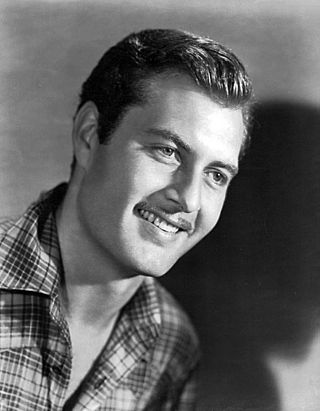
George Montgomery was an American actor, best known for his work in Western films and television. He was also a painter, director, producer, writer, sculptor, furniture craftsman, and stuntman. He was engaged to Hedy Lamarr in 1941, and married Dinah Shore in 1943.
Edward Small was an American film producer from the late 1920s through 1970, who was enormously prolific over a 50-year career. He is best known for the movies The Count of Monte Cristo (1934), The Man in the Iron Mask (1939), The Corsican Brothers (1941), Brewster's Millions (1945), Raw Deal (1948), Black Magic (1949), Witness for the Prosecution (1957) and Solomon and Sheba (1959).
King Brothers Productions was an American film production company, active from 1941 to the late 1960s. It was founded by the Kozinsky brothers, Morris, Frank, and Hyman, who later changed their professional surname to "King". They had notable collaborations with such filmmakers as Philip Yordan and William Castle and are particularly remembered today for employing a number of blacklisted writers during the Red Scare of the late 1940s and 1950s. Their films include Dillinger (1945), Suspense (1946), Gun Crazy (1949), Carnival Story (1954), The Brave One, Gorgo (1961), Captain Sindbad (1963), and Heaven With a Gun (1968).

John Brahm was a German film and television director. His films include The Undying Monster (1942), The Lodger (1944), Hangover Square (1945), The Locket (1946), The Brasher Doubloon (1947), and the 3D horror film, The Mad Magician (1954).
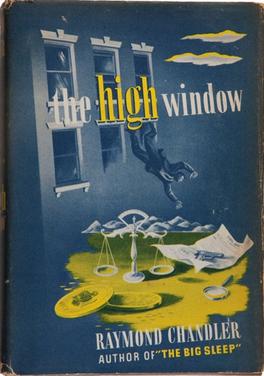
The High Window is a 1942 novel written by Raymond Chandler. It is his third novel featuring the Los Angeles private detective Philip Marlowe.

The Brasher Doubloon is a rare American doubloon of eight escudos worth sixteen dollars, privately minted in and after 1787.

Adventures of Don Juan is a 1948 American Technicolor swashbuckling adventure romance film directed by Vincent Sherman and starring Errol Flynn and Viveca Lindfors, with Robert Douglas, Alan Hale, Ann Rutherford, and Robert Warwick. Also in the cast are Barbara Bates, Raymond Burr, and Mary Stuart. The film was distributed by Warner Bros. and produced by Jerry Wald. The screenplay by George Oppenheimer and Harry Kurnitz, based on a story by Herbert Dalmas, has uncredited contributions by William Faulkner and Robert Florey.

The film appearances of movie actor Errol Flynn (1909–1959) are listed here, including his short films and one unfinished feature.
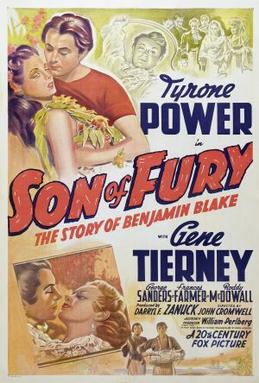
Son of Fury: The Story of Benjamin Blake is a 1942 American south seas adventure film directed by John Cromwell and starring Tyrone Power. The film was adapted from Edison Marshall's 1941 historical novel Benjamin Blake. It is notable as the last film Frances Farmer appeared in before her legal problems and eventual commitment to psychiatric hospitals until 1950.
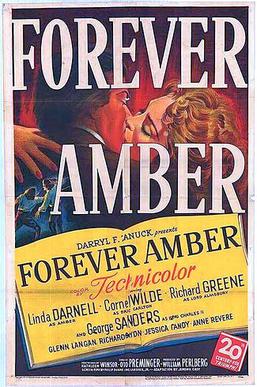
Forever Amber is a 1947 American romantic historical drama film starring Linda Darnell and Cornel Wilde. It was based on the book of the same title by Kathleen Winsor. It also starred Richard Greene, George Sanders, Glenn Langan, Richard Haydn, and Jessica Tandy.

Time to Kill is an American mystery film directed by Herbert I. Leeds. It is the first screen adaptation of Raymond Chandler's novel The High Window, which was remade five years later as The Brasher Doubloon. The detective was changed from Philip Marlowe to Michael Shayne for this version, with Lloyd Nolan playing the part and Heather Angel in a rare turn as leading lady. It is also the final Michael Shayne film starring Lloyd Nolan made at Fox, who closed down their popular B movie unit which included Mr. Moto, Charlie Chan, and the Cisco Kid. In 1946 the series would be reborn at Producers Releasing Corporation with Hugh Beaumont taking over the role.

The Thief of Venice or Il Ladro di Venezia is a 1950 Italian film directed by John Brahm. The US title was "The Thief of Venice".

Miss Susie Slagle's is a 1946 American drama film directed by John Berry. It was based on the popular novel by Augusta Tucker. The film was Berry's directorial debut and first starring role for Joan Caulfield.

Lorna Doone is a 1951 American adventure film directed by Phil Karlson and starring Barbara Hale and Richard Greene. It is an adaptation of the 1869 novel Lorna Doone by R. D. Blackmore, set in the English West Country during the 17th century.

International Pictures was an American film production company that existed in the 1940s. It merged with Universal Pictures to become Universal-International on October 1, 1946.
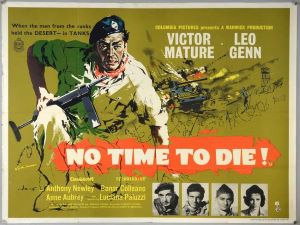
No Time to Die is a 1958 British war film directed by Terence Young and starring Victor Mature, Leo Genn, Anthony Newley and Bonar Colleano. It is about an American sergeant in the British Army during the Second World War.
Earl Felton (1909–1972) was an American screenwriter.
